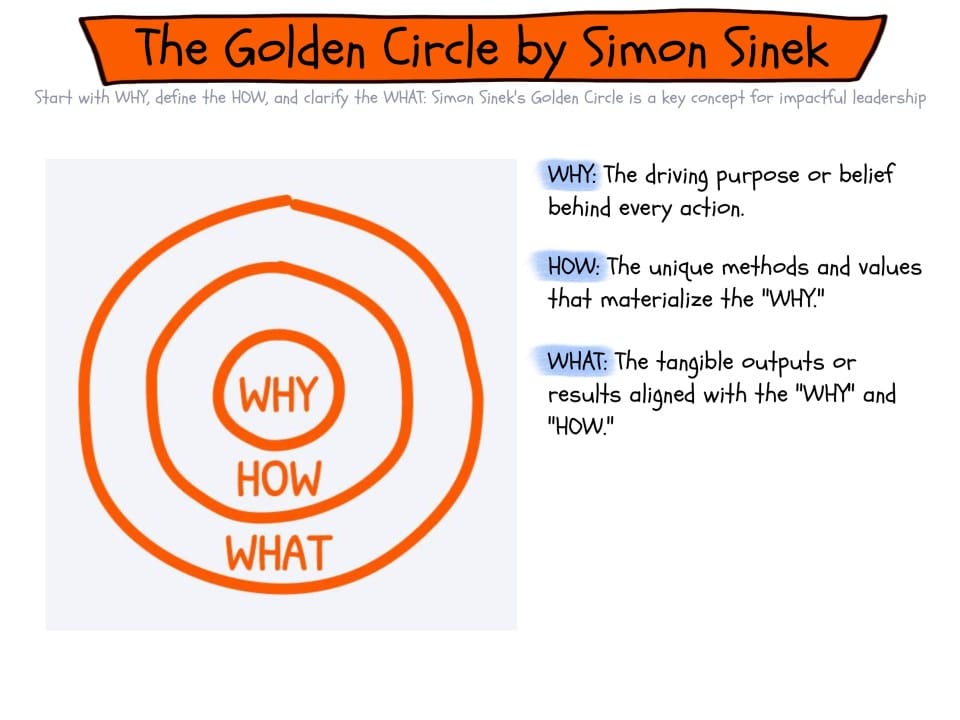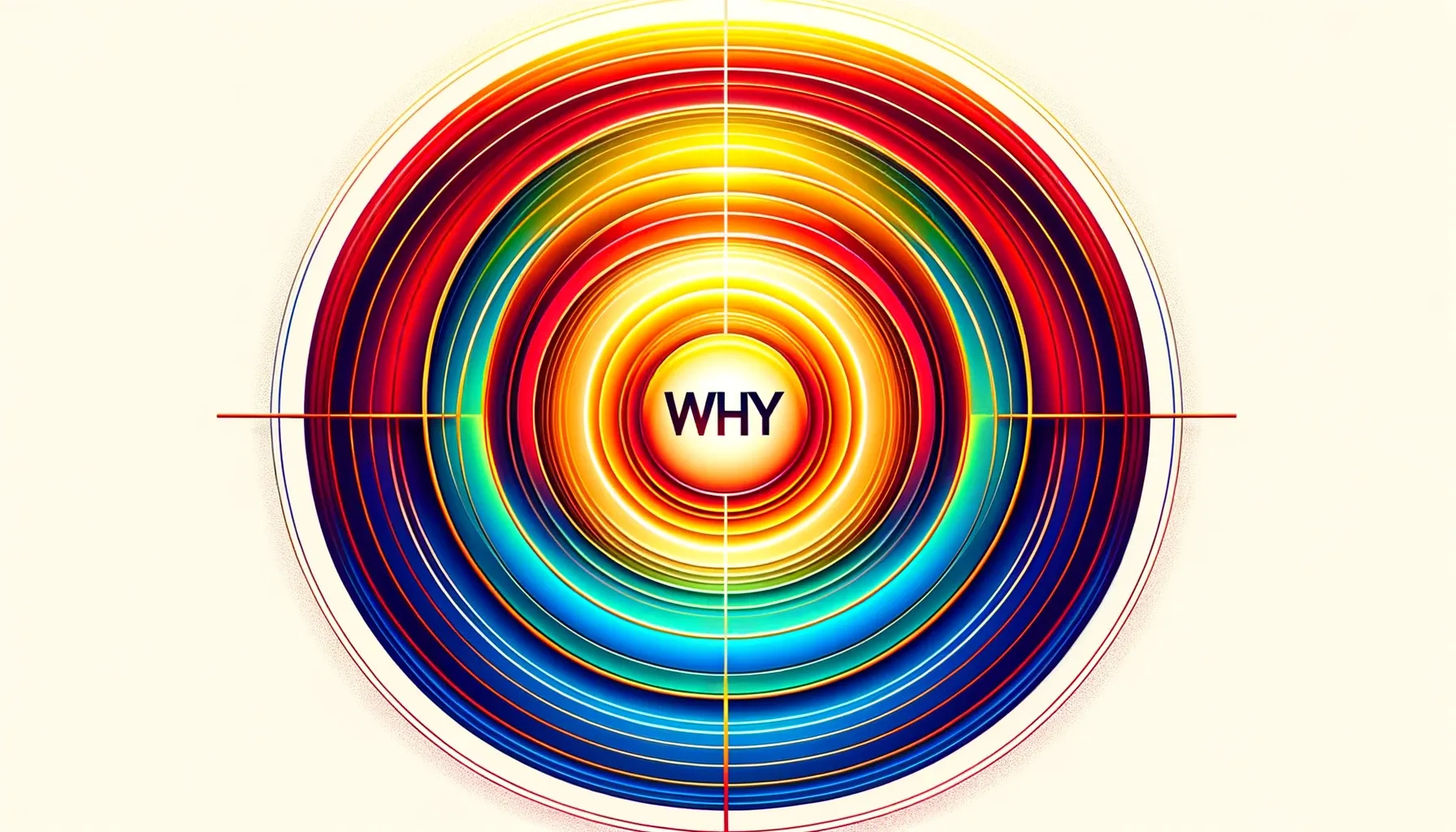On this page
This content discusses a concept known as the 'Golden Circle', which is a framework for understanding why some individuals or organizations, such as Apple, Martin Luther King, and the Wright Brothers, achieve exceptional success. Simon Sinek argues that understanding and communicating the 'why' - the purpose, cause, or belief behind what one does - is crucial to inspiring others and driving behavior. Simon also discusses how this concept applies to various aspects of life and business, from communication and decision-making to hiring practices and market conversion. The 'Golden Circle' concept is further illustrated through the contrasting examples of the Wright brothers and Samuel Pierpont Langley.

How does it apply to you?
This learning can be applied in various real-world scenarios, whether it's a startup founder trying to communicate their company's mission and attract early adopters, a team leader trying to motivate their team, or an individual trying to understand their own motivations and make meaningful decisions. By understanding and effectively communicating the 'why', we can inspire others, drive behavior, and achieve our goals.
Applied Learning to Developer Enablement
Unpacking Exceptional Success
In software development, understanding the 'hidden' factor of success can be crucial. This might be a unique approach to problem-solving, a strong team culture, or a clear vision. It's important to investigate what sets successful software development teams apart.
The Golden Circle Concept
The Golden Circle concept can be applied in software development to define project goals and communicate them effectively. It's essential to understand not just 'what' the software does and 'how' it does it, but also 'why' it's being developed.
Applying the Golden Circle to Communication
In software development teams, communication should start with 'why'. This helps team members understand the purpose of their tasks and fosters motivation and engagement.
The Power of 'Why' in Business Success
In software development, the 'why' can empower teams to create products that resonate with users. It's not about selling to anyone who needs the product, but connecting with those who share the same beliefs.
The Golden Circle and the Human Brain
Understanding the correlation between the Golden Circle and the human brain can help in designing user-friendly software. The software should not only cater to rational and analytical thought ('what') but also to feelings and decision-making ('why').
Communication and Decision-Making
Effective communication in software development involves speaking directly to the part of the brain that controls behavior. This can influence decision-making and drive user engagement.
Importance of 'Why' in Influencing Behavior
In software development, the 'why' influences how users interact with the software. It's important to communicate this 'why' effectively to influence user behavior and engagement.
The Wright Brothers Vs. Samuel Pierpont Langley
This story illustrates the importance of passion and belief in software development. Teams that are driven by a shared belief are likely to be more successful than those driven by external factors like fame or money.
People Buy 'Why' Not 'What'
In software development, users are more interested in 'why' a product was developed rather than 'what' it does. Communicating this 'why' can attract users who share the same beliefs.
Importance of Attracting Believers
In software development, it's important to attract users who believe in the 'why' of the product. This can lead to a higher adoption rate and greater success in the market.
Understanding Market Conversion
Understanding market conversion is crucial in software development. It's important to identify those users who 'get it' before doing business and strive to reach the early majority.
Innovators and Early Adopters
In software development, innovators and early adopters play a key role in the success of a product. They are willing to try new things based on their beliefs, and their feedback can be invaluable in refining the product.
Developer Checklist
Summary
Unpacking Exceptional Success
The speaker begins by raising questions about why certain individuals or organizations, like Apple, Martin Luther King, and the Wright Brothers, are able to accomplish feats that defy common assumptions. He notes that these entities aren't necessarily more equipped or advantaged than others in their fields, suggesting there's another factor at play. This introduction sets the stage for the exploration of this 'hidden' factor of success.
The Golden Circle Concept
The speaker introduces the concept of the 'Golden Circle', a simple idea he discovered that profoundly changed his worldview. This concept is based on three questions: Why? How? What? He points out that while most people and organizations know 'what' they do and 'how' they do it, very few understand 'why' they do what they do. He emphasizes that 'why' refers not to profit (a result), but to purpose, cause, or belief.
Applying the Golden Circle to Communication
The speaker applies the Golden Circle concept to communication, illustrating how most communication starts from the 'what' and moves to the 'how' and 'why'. However, he argues that inspired leaders and organizations communicate in the reverse order, starting with 'why'. He uses Apple as an example, comparing a typical, uninspiring marketing message with Apple's 'why'-first approach. He argues that people are more likely to buy products from companies when they understand and connect with the company's 'why'.
The Power of 'Why' in Business Success
The speaker further demonstrates the power of 'why' by discussing how consumers are comfortable buying a range of products from Apple, not just computers. He notes that while Apple's competitors are equally qualified to make these products, they are not as successful because they don't effectively communicate their 'why'. He concludes this segment by emphasizing that the goal of business isn't just to sell to anyone who needs the product, but to connect with those who share the same beliefs.
The Golden Circle and the Human Brain
The human brain is divided into three major components that correlate with the golden circle. The neocortex, our newest brain, aligns with the 'what' level and is responsible for rational and analytical thought as well as language. The middle two sections make up our limbic brains, which are responsible for feelings, human behavior, and decision-making, but do not have language capabilities.
Communication and Decision-Making
When we communicate from the outside in, people can understand complex information but it doesn't drive behavior. However, when we communicate from the inside out, we speak directly to the part of the brain that controls behavior, allowing people to rationalize it with the tangible things we say and do. This is where gut decisions originate from.
Importance of 'Why' in Influencing Behavior
If you do not know why you do what you do, and people respond to why you do what you do, it becomes challenging to influence people to support or buy into what you do. The goal is not just to sell to people who need what you have, but to those who believe what you believe. Similarly, hiring should not be based solely on need, but on shared beliefs.
The Wright Brothers Vs. Samuel Pierpont Langley
The Wright brothers, despite lacking funds and formal education, were driven by a belief that they could change the world with their flying machine. They were contrasted with Samuel Pierpont Langley, who, despite having abundant resources, failed because he was motivated by fame and riches rather than a core belief. The Wright brothers' team worked with passion, while Langley's team worked for paychecks. This difference in motivation led to the Wright brothers' success and Langley's failure.
People Buy 'Why' Not 'What'
People are not primarily interested in what you do, but why you do it. Talking about what you believe attracts those who share those beliefs. This principle is illustrated by the success of the Wright brothers, who were driven by belief, and the failure of Samuel Pierpont Langley, who was driven by results.
Importance of Attracting Believers
The speaker emphasizes the importance of attracting those who believe what you believe. This is linked to the law of diffusion of innovation, which categorizes people into different groups based on their openness to innovation: innovators, early adopters, early majority, late majority, and laggards. The success of an idea or product in the mass market depends on reaching a tipping point of market penetration between 15 and 18 percent.
Understanding Market Conversion
The speaker discusses the concept of market conversion, noting that most businesses have about a 10% conversion rate. The challenge lies in identifying those who 'get it' before doing business and closing the gap to reach the early majority, who are hesitant to try something new until others have tried it first.
Innovators and Early Adopters
Innovators and early adopters are comfortable making gut decisions based on their beliefs about the world. They are the ones who will stand in line for hours to buy a new product or spend a lot of money on new technology, not because of the product itself, but because of what it represents to them. They buy into the 'why' of a product, not just the 'what'.
The Law of Diffusion of Innovation in Practice
The speaker presents the example of TiVo, a high-quality product that nonetheless failed commercially. This is attributed to the fact that the company focused on what the product does, rather than why it does it. The speaker contrasts this with the success of Dr. Martin Luther King Jr., who was able to attract 250,000 people to his speech not by telling them what needed to change, but by expressing his beliefs and attracting those who shared them.
Motivation Behind Attendance
The speaker discusses the motivation behind people's attendance at a certain event. Rather than attending for the host of the event, they showed up for themselves, driven by their beliefs about America. These beliefs compelled them to endure a long journey and stand in the sun in Washington in the middle of August. The speaker notes that the crowd was not divided by race, with 25% of the audience being white.
Two Types of Laws
The speaker introduces Dr. King's belief in two types of laws in the world: those made by a higher authority and those made by humans. According to Dr. King, a just world will be achieved when all laws made by humans are consistent with those made by the higher authority. The Civil Rights Movement was seen as a vehicle for bringing this cause to life.
Inspiration Versus Planning
The speaker contrasts Dr. King's 'I have a dream' speech with the hypothetical 'I have a plan' speech. The point is that inspiration, not detailed plans, is what truly motivates people. This is further emphasized by the speaker's critique of politicians and their comprehensive 12-point plans, which fail to inspire.
Leadership and Inspiration
The speaker distinguishes between leaders and those who lead. Leaders hold positions of power or authority, but those who lead inspire us. People choose to follow those who inspire them, not out of obligation, but out of desire. The speaker concludes that individuals or organizations that start with 'why' have the ability to inspire those around them or find others who inspire them.
FAQs
What is the 'Golden Circle' concept? The 'Golden Circle' is a concept based on three questions: Why? How? What? It suggests that while most people and organizations know 'what' they do and 'how' they do it, very few understand 'why' they do what they do. 'Why' refers not to profit (a result), but to purpose, cause, or belief.
How does the Golden Circle apply to communication? The Golden Circle concept suggests that most communication starts from the 'what' and moves to the 'how' and 'why'. However, inspired leaders and organizations communicate in the reverse order, starting with 'why'. This approach is argued to be more likely to attract people to buy products when they understand and connect with the company's 'why'.
What is the correlation between the Golden Circle and the human brain? The human brain is divided into three major components that correlate with the golden circle. The neocortex, our newest brain, aligns with the 'what' level and is responsible for rational and analytical thought as well as language. The middle two sections make up our limbic brains, which are responsible for feelings, human behavior, and decision-making, but do not have language capabilities.
What is the significance of 'why' in influencing behavior? If you do not know why you do what you do, and people respond to why you do what you do, it becomes challenging to influence people to support or buy into what you do. The goal is not just to sell to people who need what you have, but to those who believe what you believe.
What was the difference between the Wright brothers and Samuel Pierpont Langley? The Wright brothers, despite lacking funds and formal education, were driven by a belief that they could change the world with their flying machine. Samuel Pierpont Langley, despite having abundant resources, failed because he was motivated by fame and riches rather than a core belief. This difference in motivation led to the Wright brothers' success and Langley's failure.
Why is it important to attract those who believe what you believe? Attracting those who believe what you believe is linked to the law of diffusion of innovation, which categorizes people into different groups based on their openness to innovation. The success of an idea or product in the mass market depends on reaching a tipping point of market penetration between 15 and 18 percent.
What is the concept of market conversion? Market conversion refers to the process of identifying those who 'get it' before doing business and closing the gap to reach the early majority, who are hesitant to try something new until others have tried it first. Most businesses have about a 10% conversion rate.
Who are innovators and early adopters? Innovators and early adopters are comfortable making gut decisions based on their beliefs about the world. They are the ones who will stand in line for hours to buy a new product or spend a lot of money on new technology, not because of the product itself, but because of what it represents to them. They buy into the 'why' of a product, not just the 'what'.
What is the Law of Diffusion of Innovation in Practice? The speaker presents the example of TiVo, a high-quality product that nonetheless failed commercially. This is attributed to the fact that the company focused on what the product does, rather than why it does it. The speaker contrasts this with the success of Dr. Martin Luther King Jr., who was able to attract 250,000 people to his speech not by telling them what needed to change, but by expressing his beliefs and attracting those who shared them.
What motivates people to attend certain events? The speaker discusses the motivation behind people's attendance at a certain event. Rather than attending for the host of the event, they showed up for themselves, driven by their beliefs about America. These beliefs compelled them to endure a long journey and stand in the sun in Washington in the middle of August.
What are the two types of laws according to Dr. King? The speaker introduces Dr. King's belief in two types of laws in the world: those made by a higher authority and those made by humans. According to Dr. King, a just world will be achieved when all laws made by humans are consistent with those made by the higher authority.
How does the speaker contrast inspiration and planning? The speaker contrasts Dr. King's 'I have a dream' speech with the hypothetical 'I have a plan' speech. The point is that inspiration, not detailed plans, is what truly motivates people.
What is the difference between leaders and those who lead according to the speaker? The speaker distinguishes between leaders and those who lead. Leaders hold positions of power or authority, but those who lead inspire us. People choose to follow those who inspire them, not out of obligation, but out of desire.






